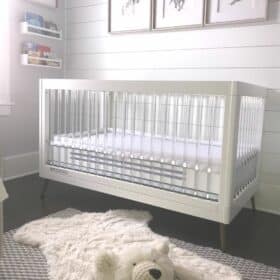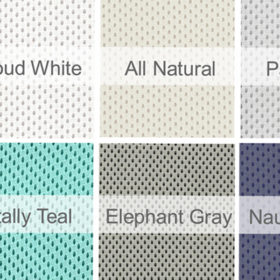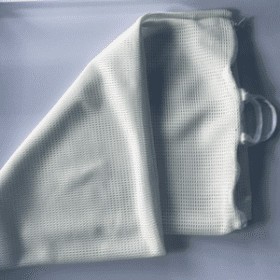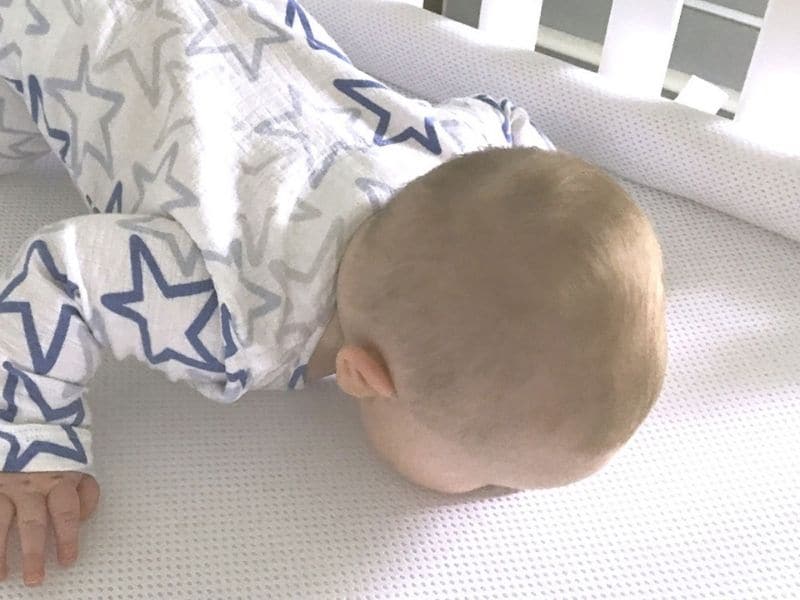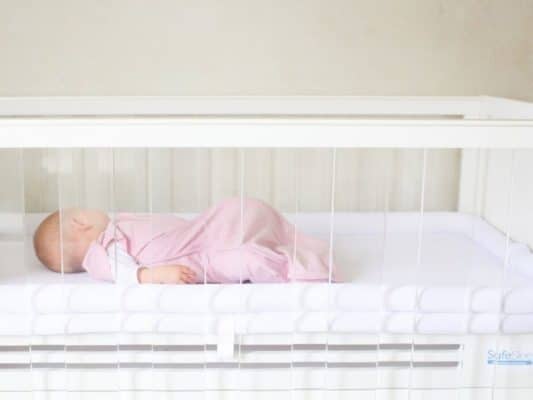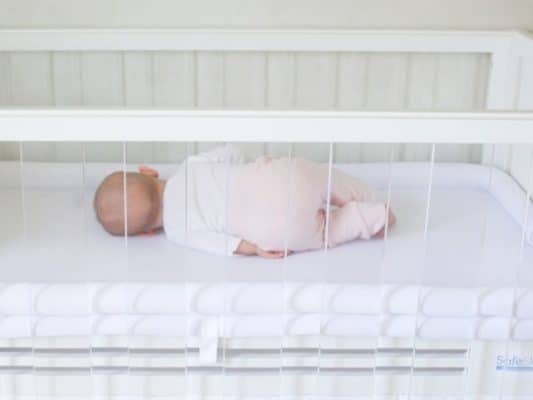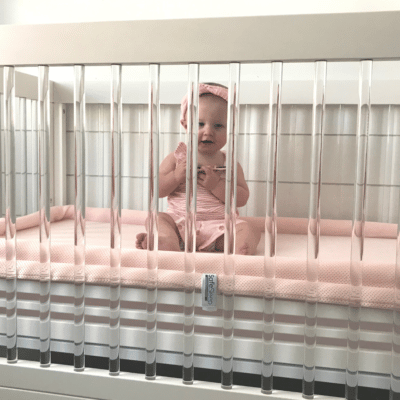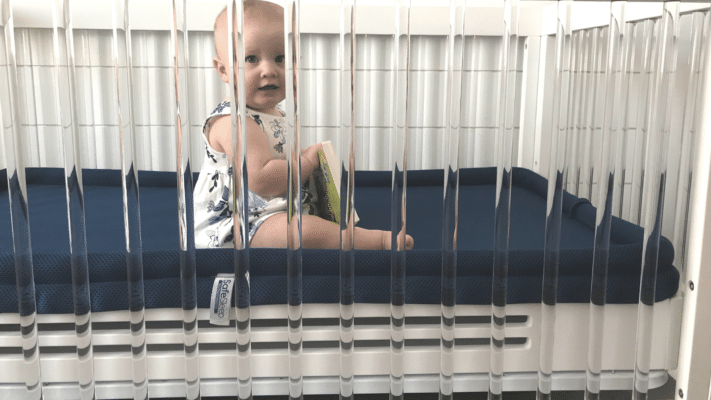No products in the cart.
Crib Mattress Facts
Why a Breathable Baby Crib Mattress Should Also Be Air Permeable
Why a Breathable Baby Crib Mattress Should Also be Air Permeable
About Breathable Crib Mattresses:
Many crib mattress companies are beginning to market their fiber filled or plastic filled baby mattresses as being “breathable.” So what is the definition of breathable? When it comes to fiber and fabrics, the definition of breathable is admitting air to the skin and allowing sweat to evaporate.
Find out more about breathable crib mattress designs by reading, Breathable Crib Mattress – Medical and Safe Sleep Experts Explain
Air Permeable
The definition of air permeable – when it comes to fibers and fabric – is the rate of airflow passing perpendicularly through a known area under a prescribed air pressure differential between two surfaces of a material.
Many parents believe a breathable crib mattress is the same as a completely air-permeable crib mattress. There are some similarities between a breathable baby crib mattress and a completely air-permeable crib mattress. Both admit air to the skin. And, both allow sweat to evaporate.
However, the completely air-permeable crib mattress is the only crib mattress that is recognized by medical professionals and safe sleep experts as addressing the risk factors associated with infant sleep related deaths.
Air-Permeable vs. Breathable Crib Mattress and the AAP
In fact, the SafeSleep® Breathe-Through Crib Mattress created by Safe Sleep Technologies, (formerly Secure Beginnings) is the only breathable crib mattress that is also completely air permeable.
The SafeSleep® breathable crib mattress allows a baby who is sleeping face down to breathe normally. And there is no risk of rebreathing dangerous carbon dioxide.
The SafeSleep® air-permeable crib mattress is the only breathable crib mattress on the market today that is approved and endorsed by leading American Academy of Pediatric (AAP) physicians. In fact, it was designed by an AAP pediatrician.
In 2011, Dr. Margie Andreae and her sister Julie – the creator of the first commercially viable breathable crib mattress that is also air permeable – began challenging the AAP’s Safe Sleep Task Force. The wanted the relevant test data on a completely air-permeable crib mattress to be included in the safe sleep policy. This test data proves the SafeSleep® breathable crib mattress reduces the many risk factors associated with infant’s health and safe sleep.
The pair used scientific literature and supported rationale to convince the Safe Sleep Task Force to recognize the safety and health benefits of a completely air-permeable – breathable crib mattress.
The AAP’s Task Force on Sudden Infant Death Syndrome’s technical report was originally published online October 17, 2011 in Pediatrics.
Dr. Rachel Moon, the Chair of the Task Force, maintains that there was no data to support the use of breathable crib mattresses to prevent SIDS/Suffocation at that time.
Relevant Scientific Test Data
Relevant scientific test data shows the breathable crib mattress by Safe Sleep Technologies:
- Reduces the risk of CO2 rebreathing compared to a fiberfill mattress,
- Eliminates the use of a crib sheet and potential for entanglement, and
- Reduces Staph aureus colonization by eliminating the fiber fill or plastic core.
CO2 Retention and the Risk of Rebreathing
Prior to the publication of the AAP Task Force report, studies were available that clearly demonstrated that the risk of rebreathing of exhaled air (CO2) was lowest on breathable crib mattresses that are also air permeable (Kemp 2000, Bar-Yishay 2011).
In addition, Dr. Moon was provided with test data from Intertek, a CPSC accredited and recommended lab, showing a significantly low risk hazard of rebreathing on the SafeSleep® breathable crib mattress. Also, it was significantly lower than the firm fiber fill crib mattress with tight fitting sheet.
The data demonstrates an air-permeable crib mattress has significantly lower CO2 retention. All three reports use similar test methods and have similar results.
The three studies of breathable crib mattresses that are also air-permeable do not demonstrate a direct prevention of SIDS. However, they rely on the hypothesis of rebreathing of CO2 as a potential contributor for unexpected infant deaths.
Indeed, no studies have substantiated the rebreathing hypothesis. However, this is the same hypothesis used by the AAP Task Force to support many of their recommendations. The recommendations include the following quotes taken from the AAP Task Force report.
- Supine sleep position: “The prone or side sleep position can increase the risk of rebreathing expired gases, resulting in hypercapnia and hypoxia.”
- Room-Sharing Without Bed-Sharing Is Recommended: “Bed-sharing might increase the risk of overheating, rebreathing or airway obstruction, head covering, and exposure to tobacco smoke, which are all risk factors for SIDS.”
- It Is Prudent to Provide Separate Sleep Areas and Avoid Cobedding for Twins and Higher-Order Multiples in the Hospital and at Home: “Furthermore, there is increased potential for overheating and rebreathing while cobedding, and size discordance might increase the risk of accidental suffocation.”
- Pillows, Quilts, Comforters, Sheepskins, and Other Soft Surfaces Are Hazardous When Placed Under the Infant or Loose in the Sleep Environment: “However, such soft bedding can increase the potential of suffocation and rebreathing.”
- Avoid Overheating and Head Covering in Infants: “It is not known whether the risk associated with head covering is attributable to overheating, hypoxia, or rebreathing.”
Air Permeable Sides in Bassinets
In addition, the Task Force recommends air permeable sides when bassinets are used. This recommendation is based on a retrospective review and analysis of infant deaths occurring in bassinets between June 1990 and November 2004 that were reported to the CPSC (Pike/Moon 2008).
The authors identified at least six infants who were found unresponsive with their “face wedged against the side of the bassinet.” While there is no mention of any bassinets having air permeable sides in the study, the study authors recommends “a bassinet with vertical sides of air-permeable material, such as mesh, may be preferable to one with air-impermeable sides.”
The Task Force makes the recommendation for air permeable sides based on infants with face wedged against side of sleep environment. But, the fail to recommend air-permeable crib mattresses as being preferable to air-impermeable crib mattresses to address infants face-straight- down on firm mattresses. This is despite the continued report of such deaths.
Fiberfill Mattress vs. Breathable Crib Mattress that are Also Completely Air-Permeable
The AAP Task Force’s accompanying policy statement (AAP, 2011) recommends the following sleep surface: “Use a firm sleep surface—A firm crib mattress, covered by a fitted sheet. This is the recommended sleeping surface to reduce the risk of SIDS and suffocation.”
Here the authors are stating that the firm crib mattress reduces the risk of SIDS. Even though they list this recommendation as Level A, they fail to provide the citations that support this recommendation in the policy statement. Further, there are no citations to be found.
In referring back to the technical report, the authors rely on the CPSC recommendations to support their recommendation for the firm crib mattress:
“Cribs should meet safety standards of the CPSC, Juvenile Product Manufacturers Association, and the ASTM International (formerly the American Society for Testing and Materials), including those for slat spacing, snugly fitting and firm mattresses, and no drop sides.121”
This citation [121 US Consumer Product Safety Commission. Crib Safety Tips: Use Your Crib Safely. Washington, DC: US Consumer Product Safety Commission. CPSC document 5030] is a tip sheet written for parents and caregivers.
It is not a well-conducted case-control study, a systematic review, or a meta-analysis. No other citation is provided. The citations for this recommendation do not meet the Level A requirements.
Dr. James Kemp and Colleagues
Dr. James Kemp and colleagues are some of the first to study the potential for various sleep surfaces to prevent infant rebreathing (Kemp 2000). They found that the firm mattress and four of the five surfaces designed to prevent rebreathing consistently allowed lethal rebreathing of CO2.
Only one product—a breathable crib mattress that is also air permeable—was able to maintain CO2 levels below this threshold. The authors go on to say that “even firm crib mattresses could pose a rebreathing threat when vulnerable infants sleep prone.”
They refer to studies showing that unaccustomed prone sleepers, including infants who are placed supine and roll prone have an increased risk of SIDS (L’Hoir 1998 and Mitchell EA 1999).
These studies and others show nearly half of SIDS victims unaccustomed to prone sleep, were discovered in the face-straight-down position. Many of these infants were found on a firm, fiber filled, crib mattress.
Dr. Kemp’s data supports that if vulnerable infants are placed on an air-permeable crib mattress or surface, they would experience less risk of rebreathing should they inadvertently roll prone. There is no reference to breathable crib mattresses that are not completely air-permeable reducing CO2 levels or reducing risks.
Dr. Ephram Bar-Yishay and Colleagues
Dr. Ephraim Bar-Yishay and colleagues provided the second study on CO2 accumulation and rebreathing on six infant sleep surfaces—a breathable baby crib mattress that is also air permeable, two conventional firm crib mattresses and three mattresses with an additional layer or topper designed to improve air flow. These toppers are similar to the toppers on current crib mattresses claiming to be “breathable crib mattresses”. (Bar-Yishay 2011).
The breathable baby crib mattress that is also air permeable had a significantly faster rate of CO2 elimination. Additionally, only the breathable crib mattress that is also air permeable was able to prevent CO2 accumulation with maximal CO2 levels significantly lower than that of the other crib mattresses.
They concluded that the breathable crib mattress that is also air permeable exhibited significantly better aeration properties compared to the other five mattresses – including the firm crib mattresses.
The crib mattresses with “breathable” toppers to improve airflow – now being marketed as breathable crib mattresses – actually had higher rates of CO2 than the conventional crib mattress with no breathable cover.
Safe Sleep Technologies
Finally a U.S. manufacturer of a breathable crib mattress that is also air permeable contacted the CPSC for recommendations on an accredited independent lab to conduct similar tests on aeration properties on their product.
Intertek was recommended because they use a similar mechanical model and methods as designed by Dr. Kemp. The lab compared CO2 elimination on four different surfaces—the air-permeable, breathable rib mattress a firm mattress with tight fitting sheet, sheepskin, and a bean bag chair.
The latter two are known high risk hazards for rebreathing (Kemp 1991, Kemp 1993). They have been implicated in a significant number of SIDS fatalities. Just as in the studies by Kemp and Bar-Yishay, the air-permeable, breathable crib showed significantly less CO2 retention than the firm crib mattress and the high hazard comparators.
Intertek concluded that the breathable crib mattress by SafeSleep® represents a significantly lower risk hazard for rebreathing than the firm crib mattress. They also compared the air permeability of the breathable crib mattress by SafeSleep® to a firm crib mattress using the ASTM-D737-04 standard test method of air permeability of textiles.
Based on the test data, the breathable crib mattress by SafeSleep® has an air permeability rate over 330 times greater than the firm crib mattress.
That is some impressive airflow.
These two well-designed, well-conducted case controlled studies along with the independent CPSC testing lab results strongly support a recommendation for use of an air-permeable, breathable crib mattress.
Just as the Task Force’s five Level A recommendations listed above are all based in some part on risk of rebreathing, it stands to reason that the Task Force would recommend the air-permeable, breathable baby mattress since it has a significantly lower risk of rebreathing. The rebreathing risk is much lower than the firm crib mattress with tight fitting sheet.
Suffocation/Entanglement in Bedding: Crib Sheets
The AAP Task Force concurs with the CPSC that all loose bedding should be removed from the infants sleep environment. The CPSC and the AAP issued an alert in 2001 warning parents and pediatricians of the “hidden hazard in babies’ cribs.” This hazard is loose crib mattress sheets. This warning is based on death reports of infants who suffocated or strangled when they became entangled in their crib mattress sheet. Two of the deaths involved fitted crib sheets.
The CPSC now requires that all crib mattress sheets carry a warning that the sheet should not be used if it doesn’t fit properly. CPSC pushed the sheet-making industry to improve the fit of sheets on crib mattresses. However deaths from sheet entanglement remain a risk for infants.
In the CDC’s multistate SUID Case Registry, the mechanism most frequently reported for possible and unexplained suffocation deaths was soft bedding which the registry defines as soft or loose bedding (Shapiro-Mendoza 2014). The loose bedding is not further defined but could be a blanket or fitted sheet that became loose.
Crib mattress manufacturers are not sheet manufacturers. The CPSC defines the industry requirements for mattress size based on ASTM standards. Their length and width requirements are consistent. However, their requirement for height is six inches or less. This makes mattress sizes inconsistent.
Because there are no crib sheets made for a given mattress, the crib sheet remains a hazard. The design of the breathable crib mattress that is also air permeable eliminates this risk because no sheet or other bedding is used. Breathable crib mattresses that are not air permeable, still use a sheet.
The same data used by the AAP Safe Sleep Task Force in its recommendation against the use of soft or loose bedding, also supports a recommendation against the use of a crib mattress sheet when possible.
Roll of Bacteria and Fiber Fill in Crib Mattresses
A peer-reviewed article attempts to establish bacterial infection as having a major role in the pathophysiology of SIDS (Goldwater 2013). The authors debunk the respiratory physiology mode. They claim both are unproven and inconsistent with the most plausible physiological events that take place during a SIDS death.
A recent study showed SIDS victims, especially those found on their stomach, are more often colonized with Staph aureus than living control subjects (Highet 2014). Studies demonstrate colonization of traditional fiber filled crib mattresses with Staph aureus (Sherburn 2007) suggesting a source for acquiring these bacteria.
While no studies are available measuring colonization of breathable crib mattresses, the surface is designed to be removed and machine washed. The SafeSleep® by Safe Sleep Technologies, recommends regular cleaning of the surface in a conventional washer and dryer.
Crib mattresses that have fiber or other fills can become contaminated.
Based on the bacterial infection hypothesis, it stands to reason the AAP Safe Sleep Task Force should consider recommending regular washing of infant sleep surfaces and removal of fillers from crib mattresses to reduce exposure to these pathogens.
After a long evidentiary process, the 2016 Safe Sleep Technical report now recognizes the safety advantages of air-permeable, breathable crib mattresses in reducing the risk of unexpected suffocation/entanglement and other hazards that may be associated with SIDS.
We cannot say with scientific certainty that a breathable crib mattress will help avoid SIDS. However, the SafeSleep® is considered the best crib mattress for addressing all the risk factors associated with infant sleep.
The AAP does not recommend the use of breathable crib mattresses that are not also air permeable to reduce the risk of SIDS and other infant sleep related deaths.
Find out more about the cost advantages of a breathable crib mattress. Read our article, Is a Breathble Crib Mattress Worth it?
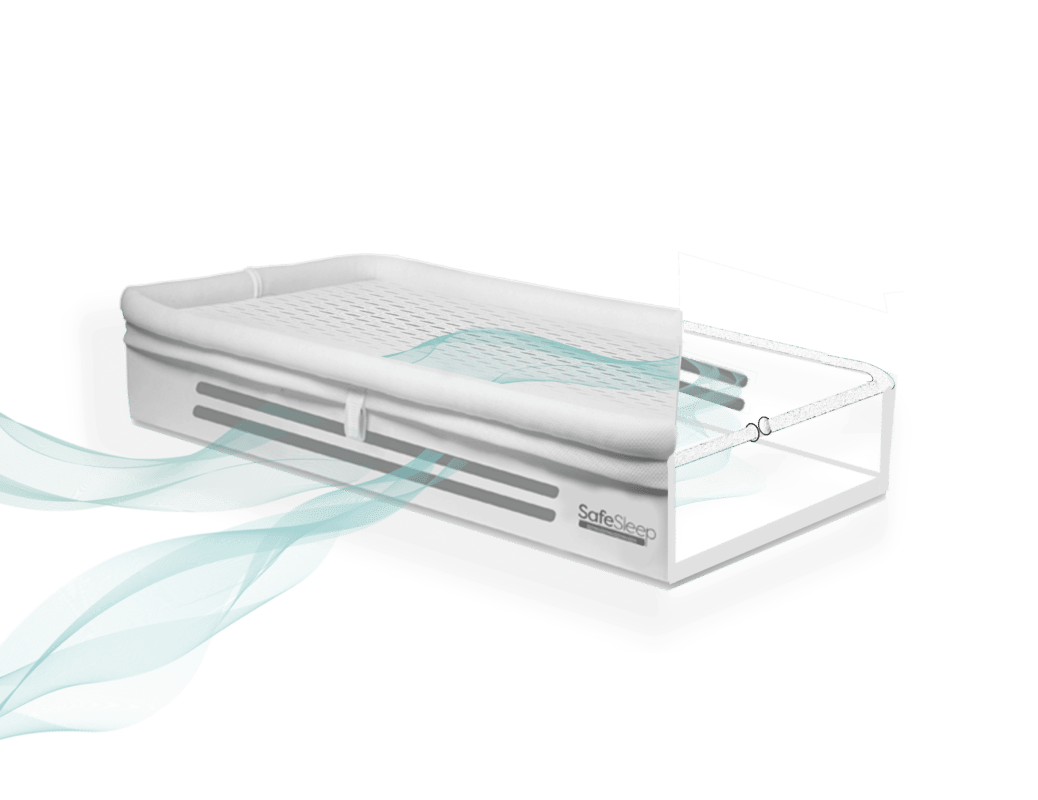
Refrences:
Paul N. Goldwater1,2 and Karl A. Bettelheim. SIDS Risk Factors: Time for New Interpretations.
Related Topics


